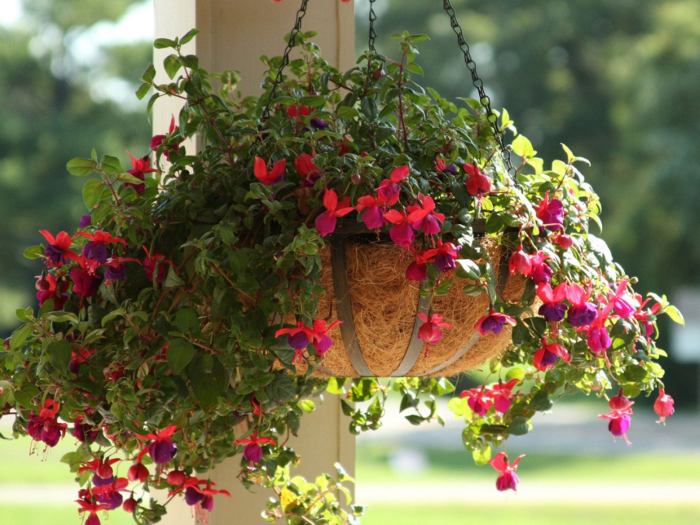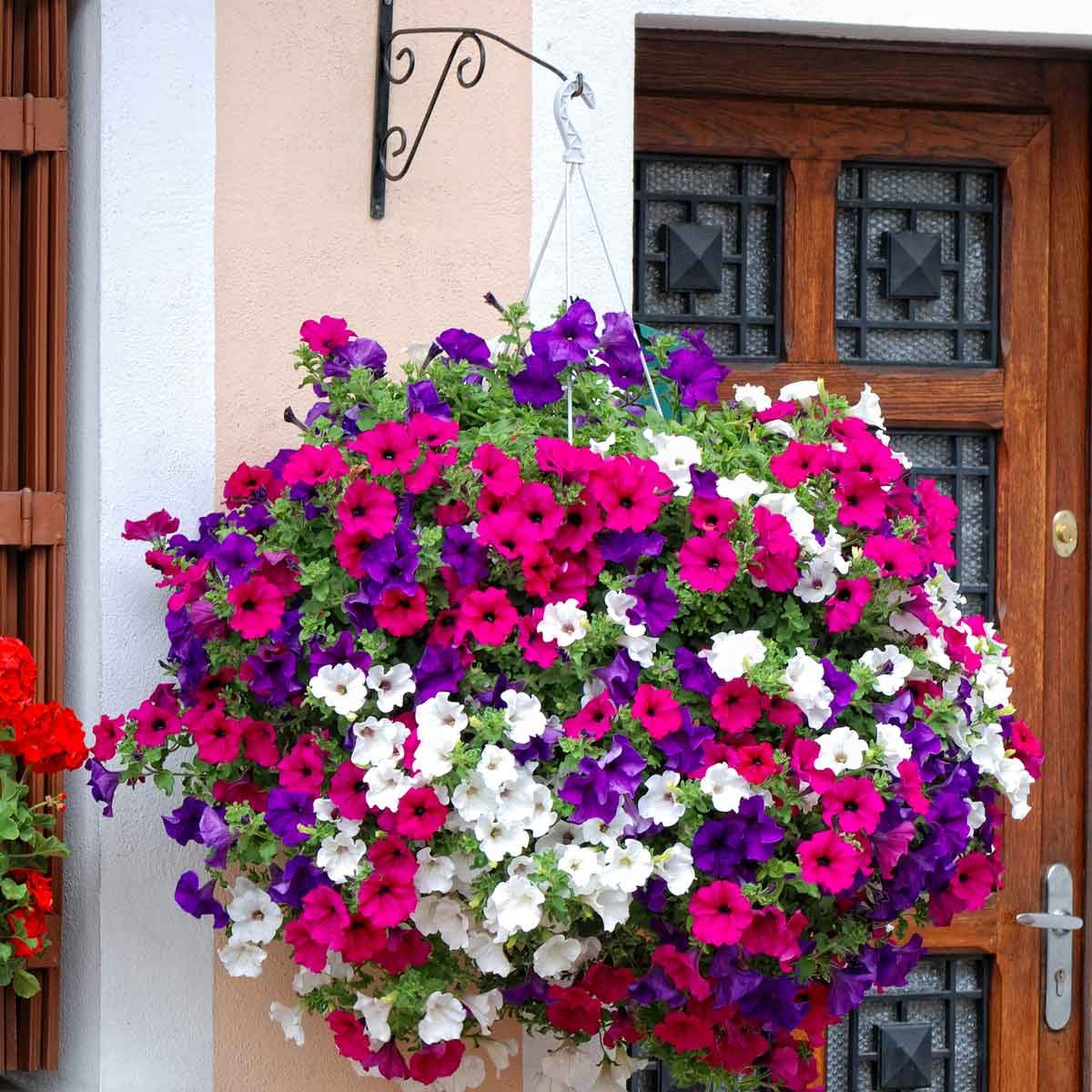Hanging plants for shade offer a captivating solution to enhance the aesthetics and functionality of shaded areas. From lush greenery to vibrant blooms, these plants bring life and color to otherwise dull spaces, creating a tranquil and inviting atmosphere.
Whether adorning a shady patio, porch, or indoor nook, hanging plants provide a myriad of benefits, including air purification, privacy screening, and visual interest. Their cascading foliage and delicate blooms add a touch of elegance and charm to any setting.
Types of Hanging Plants for Shade
Hanging plants add a touch of greenery and elegance to any shaded area. They are a great way to bring nature indoors, even in spaces with limited natural light. There are many different types of hanging plants that are suitable for shaded areas, each with its own unique characteristics.
Some of the most popular hanging plants for shade include:
- Fernsare a classic choice for hanging baskets in shaded areas. They come in a wide variety of shapes and sizes, from delicate maidenhair ferns to large Boston ferns. Ferns prefer moist, well-drained soil and indirect light.
- Pothosis another popular choice for hanging baskets in shaded areas. It is a fast-growing vine with heart-shaped leaves that come in a variety of colors, including green, yellow, and white. Pothos is very easy to care for and can tolerate low light conditions.
- Spider plantsare another good choice for hanging baskets in shaded areas. They are a fast-growing plant with long, thin leaves that produce small plantlets. Spider plants are very easy to care for and can tolerate low light conditions.
- Peace liliesare a beautiful choice for hanging baskets in shaded areas. They have large, dark green leaves and white flowers that bloom in the spring and summer. Peace lilies prefer moist, well-drained soil and indirect light.
- String of heartsis a unique and beautiful hanging plant that is perfect for shaded areas. It has long, trailing stems with heart-shaped leaves that are variegated in green and white. String of hearts prefers bright, indirect light and well-drained soil.
Benefits of Hanging Plants in Shaded Areas
Hanging plants are not just decorative additions to shaded areas; they offer a myriad of benefits that enhance the aesthetics, air quality, and overall ambiance of these spaces.
When selecting hanging plants for shade, consider their nectar-producing potential. Hummingbirds, drawn to these sweet treats, can add a touch of vibrant life to shaded areas. Explore a range of hanging plants for hummingbirds , such as fuchsia, honeysuckle, and salvia, to attract these captivating creatures while providing much-needed shade to your outdoor space.
Aesthetic Enhancement
Hanging plants add a touch of greenery and vibrancy to shaded areas, transforming them from dull and uninviting to lively and inviting. Their cascading foliage creates a lush and verdant canopy that can instantly uplift the mood and create a sense of tranquility.
Air Purification
Certain hanging plants, such as ferns, spider plants, and peace lilies, are known for their air-purifying abilities. They absorb toxins and pollutants from the air, improving indoor air quality and creating a healthier environment.
Privacy
Hanging plants can provide a natural privacy screen in outdoor settings, such as patios or balconies. Their dense foliage can obstruct unwanted views and create a secluded and intimate atmosphere.
Visual Interest
Hanging plants add visual interest and depth to shaded areas. Their varying shapes, textures, and colors create a dynamic and captivating display that draws the eye and enhances the overall aesthetics of the space.
Examples of Usage
Hanging plants can be used in various settings to create different effects:
- On patios or balconies, they provide shade, privacy, and a touch of greenery.
- In indoor living rooms, they purify the air, add visual interest, and create a cozy atmosphere.
- In bathrooms, they thrive in the humid environment and add a touch of freshness.
- In kitchens, they can be used as herb gardens, providing fresh herbs for cooking.
Care and Maintenance of Hanging Plants in Shade

Maintaining the health and vitality of hanging plants in shaded areas requires specific care practices. Understanding the unique needs of these plants is essential to ensure their optimal growth and well-being.
Watering requirements vary depending on the plant species and the amount of shade it receives. Generally, plants in heavily shaded areas need less frequent watering than those in brighter locations. It is important to allow the soil to dry out slightly between waterings to prevent overwatering and root rot.
Avoid letting the soil become completely dry, as this can also damage the plant.
Hanging plants are a great way to add shade to your home, while also adding a touch of style. For those looking for hanging plants decor ideas, there are many resources available online. One such resource is hangingplantsindoor.com , which provides a variety of ideas for using hanging plants to decorate your home.
From macrame hangers to geometric planters, there are many ways to incorporate hanging plants into your decor. With a little creativity, you can use hanging plants to create a beautiful and inviting space.
Fertilizing hanging plants in shade is crucial for providing essential nutrients. Choose a balanced liquid fertilizer and apply it according to the manufacturer’s instructions. Fertilize less frequently during the winter months when plant growth slows down.
Pruning hanging plants in shade helps maintain their shape and encourage new growth. Remove any dead or damaged leaves or stems promptly. For some species, such as ferns, pruning can also help promote bushier growth.
Pest and Disease Management
Hanging plants in shade can be susceptible to pests and diseases, especially if they are not properly cared for. Common pests include aphids, mealybugs, and spider mites. These pests can be controlled using insecticidal soap or neem oil. Diseases such as powdery mildew and botrytis can also affect hanging plants in shade.
These diseases can be treated with fungicides.
Design Considerations for Hanging Plants in Shade: Hanging Plants For Shade
Hanging plants add a touch of greenery and life to shaded areas, but careful planning is necessary to ensure their visual appeal and health. Here are some design considerations to keep in mind:
Hanging Plant Arrangements
- Single plant:A single hanging plant creates a focal point and can add height to a space.
- Group of plants:Grouping plants together creates a lush, cascading effect.
- Mixed arrangement:Combining plants with different textures, colors, and shapes creates a visually interesting display.
Hanging Container Selection, Hanging plants for shade
The choice of hanging container depends on factors such as:
- Material:Consider the durability, weight, and aesthetics of materials like plastic, metal, ceramic, and wicker.
- Size:Choose a container that is proportionate to the size of the plant and the desired visual impact.
- Shape:Round, square, or rectangular containers create different visual effects.
Incorporating Hanging Plants into Existing Landscapes
When incorporating hanging plants into existing landscapes or interior designs, consider the following:
- Vertical space:Utilize vertical space by hanging plants from trees, fences, or pergolas.
- Focal points:Create focal points by hanging plants near seating areas or entrances.
- Color scheme:Consider the color scheme of the surrounding area when choosing plant foliage and flowers.
Troubleshooting Common Issues with Hanging Plants in Shade

Hanging plants in shaded areas can encounter specific challenges that require prompt attention. By identifying common issues and implementing effective solutions, you can ensure the health and beauty of your hanging plants.
To effectively troubleshoot problems with hanging plants in shade, observe the plant closely for any visible symptoms, such as yellowing leaves, stunted growth, or the presence of pests. Once the issue is identified, take appropriate steps to resolve it and prevent future occurrences.
For those seeking shade and greenery, hanging plants are an ideal solution. Bunnings, a renowned home improvement retailer, offers an extensive selection of hanging indoor plants that can transform any indoor space. From cascading ferns to lush vines, these plants not only provide shade but also purify the air, creating a serene and inviting atmosphere.
Yellowing Leaves
- Cause:Overwatering or nutrient deficiency
- Solution:Check soil moisture and adjust watering schedule accordingly. Fertilize the plant regularly with a balanced fertilizer.
Stunted Growth
- Cause:Lack of sunlight or inadequate nutrition
- Solution:Provide additional indirect light or move the plant to a brighter location. Ensure the plant is receiving sufficient nutrients by fertilizing regularly.
Pests
- Cause:Aphids, mealybugs, or spider mites
- Solution:Inspect the plant regularly for pests. Use insecticidal soap or neem oil to treat infestations. Consider using companion planting to deter pests.
Final Conclusion
Incorporating hanging plants into shaded areas requires careful consideration of plant selection, care, and design. By choosing the right species, providing proper maintenance, and incorporating creative arrangements, you can create a thriving oasis that transforms your shaded spaces into vibrant and inviting havens.
Essential FAQs
What are the best hanging plants for shade?
Some popular hanging plants suitable for shaded areas include ferns, ivy, pothos, spider plants, and begonias.
How often should I water hanging plants in shade?
Water hanging plants in shade when the top inch of soil feels dry to the touch, but avoid overwatering.
What are some tips for preventing pests on hanging plants in shade?
Regularly inspect your plants for pests and treat them promptly with an appropriate insecticide. Keep the area around your plants clean and free of debris to reduce the risk of infestation.